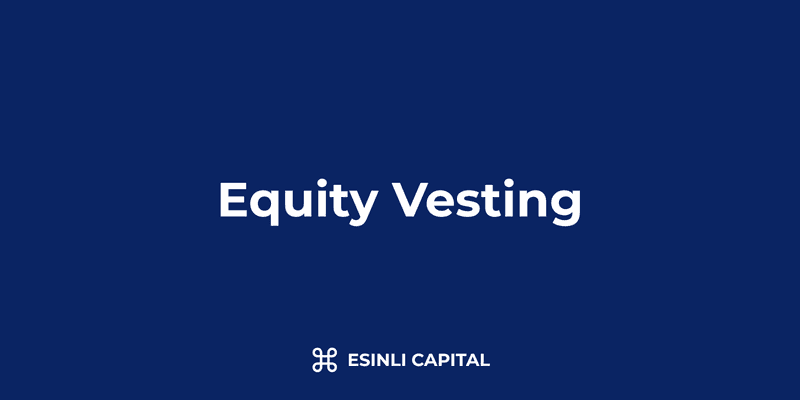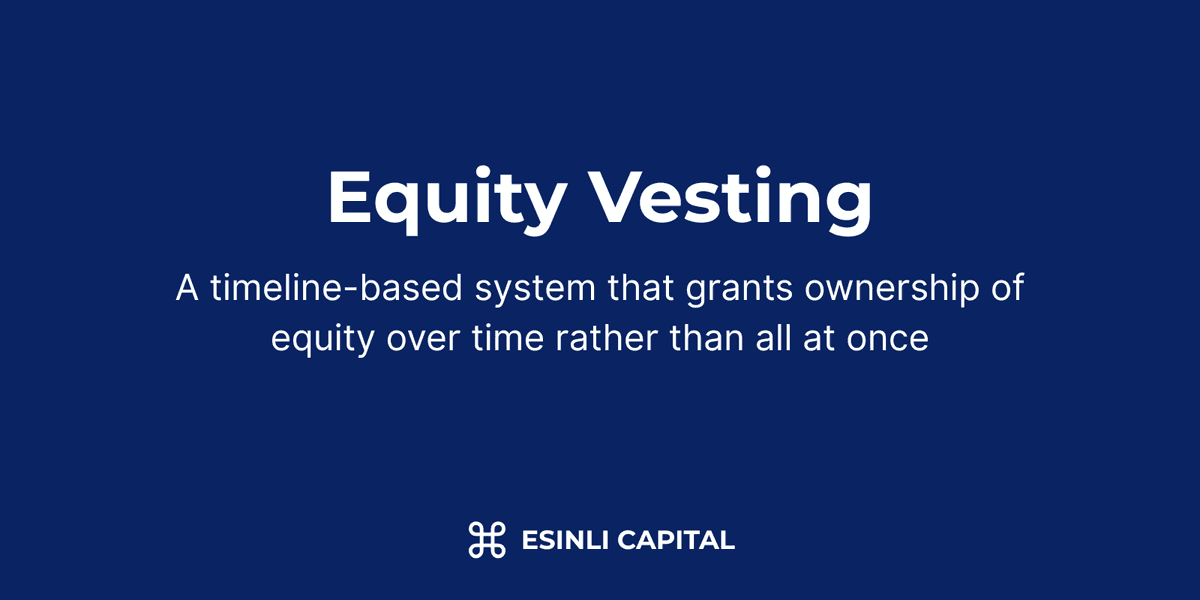In This Article
- What Is an Equity Vesting Schedule?
- Understanding Equity Vesting Schedules
- Types of Vesting Schedules
- The Vesting Cliff
- Acceleration Triggers
- Founder Vesting Considerations
- Employee Equity Vesting
- Time-Based vs. Milestone-Based Vesting
- Stock Option Vesting vs. RSU Vesting
- Practical Considerations for Equity Vesting
- Acceleration Triggers in Detail
- Comparing Vesting Schedules Across Companies
- FAQ on Equity Vesting Schedules
- The Future of Equity Vesting Schedules
- The Bottom Line
- What Is an Equity Vesting Schedule?
- Understanding Equity Vesting Schedules
- Types of Vesting Schedules
- The Vesting Cliff
- Acceleration Triggers
- Founder Vesting Considerations
- Employee Equity Vesting
- Time-Based vs. Milestone-Based Vesting
- Stock Option Vesting vs. RSU Vesting
- Practical Considerations for Equity Vesting
- Acceleration Triggers in Detail
- Comparing Vesting Schedules Across Companies
- FAQ on Equity Vesting Schedules
- The Future of Equity Vesting Schedules
- The Bottom Line

Equity Vesting: Structure, Cliffs & Acceleration
What Is an Equity Vesting Schedule?
An equity vesting schedule is a timeline that determines when a person gains full ownership rights to equity (such as stock options or restricted stock units) granted by a company. Rather than receiving all shares upfront, recipients earn their equity gradually over a predetermined period, typically 3-4 years. This arrangement protects companies from individuals who might leave shortly after receiving valuable equity and incentivizes long-term commitment from founders, employees, and other stakeholders.
KEY TAKEAWAYS
- Equity vesting schedules release ownership rights to company shares over time instead of all at once, typically over a 3-4 year period.
- Most vesting schedules include a "cliff" (usually 1 year) where no equity vests until that point, after which vesting occurs monthly or quarterly.
- Acceleration clauses can trigger immediate vesting upon certain events like company acquisition (single trigger) or termination following acquisition (double trigger).
- Different vesting structures exist: time-based (standard), milestone-based (tied to achievements), and hybrid approaches.
- Founders typically face stricter vesting requirements from investors, while vesting terms for employees vary based on role, seniority, and company stage.
Understanding Equity Vesting Schedules
Vesting schedules represent the timeline over which equity ownership transfers to individuals. This mechanism serves multiple purposes in startups and established companies alike. For startups, it ensures founding team members remain committed during crucial early stages. For all companies, it helps retain talent by providing increasing financial incentives the longer someone stays.
The most common vesting schedule is a four-year period with a one-year cliff, meaning:
- No equity vests during the first year (the "cliff")
- After the one-year cliff, 25% of the total equity grant vests immediately
- The remaining 75% vests gradually (typically monthly or quarterly) over the next three years
For example, if a startup grants an employee 4,000 shares subject to a four-year vesting schedule with a one-year cliff:
- The employee receives no shares for the first year
- At the one-year mark, 1,000 shares (25%) vest immediately
- For the remaining three years, approximately 83 shares vest each month (or 250 shares quarterly)
The Purpose of Vesting Schedules
Vesting schedules serve several important functions:
- Protection for the company: They prevent scenarios where someone receives equity and immediately leaves.
- Retention tool: They provide financial incentive for employees and founders to stay with the company longer.
- Alignment of interests: They ensure key stakeholders are motivated to contribute to long-term company success.
- Risk management: They allow companies to allocate equity without immediate dilution of control.
The vesting concept applies to various forms of equity, including:
- Founder shares
- Stock options
- Restricted stock units (RSUs)
- Profits interests (in LLCs)
- Performance shares
Types of Vesting Schedules
While the standard four-year schedule with a one-year cliff is most common, several variations exist to suit different company needs and circumstances.
Time-Based Vesting
Time-based vesting is the standard approach where equity vests based solely on the passage of time. After meeting the cliff requirement, vesting typically occurs:
- Monthly: Equity portions vest at the end of each month
- Quarterly: Larger portions vest every three months
- Annually: 25% of equity vests each year (less common due to retention concerns)
Milestone-Based Vesting
Rather than time, milestone-based vesting ties equity release to specific achievements:
- Performance targets: Revenue goals, user acquisition metrics, product launches
- Business development: Securing key partnerships, entering new markets
- Funding rounds: Successfully raising Series A, B, or C funding
This approach is less common for regular employees but may be appropriate for specialized roles (like business development) or consultants.
Hybrid Vesting
Hybrid schedules combine time-based and milestone-based elements:
- A portion vests based on time (e.g., 60%)
- The remainder vests upon achieving specific milestones (e.g., 40%)
This balances predictable long-term incentives with motivation to hit strategic goals.
The Vesting Cliff
The vesting cliff is a period at the beginning of the vesting schedule during which no equity vests. If the recipient leaves before reaching the cliff, they forfeit all equity.
Purpose of the Cliff
The cliff serves several purposes:
- It protects companies from brief commitments – individuals must demonstrate commitment for a meaningful period
- It reduces administrative burden by avoiding small equity distributions to short-term employees
- It provides time to evaluate whether the relationship will be successful
Standard Cliff Periods
- One year: The most common cliff period for both founders and employees
- Six months: Sometimes used for senior executives or in competitive hiring markets
- Three months: Occasionally used for highly sought-after talent or specialized consultants
Some companies offer "cliff vesting," where a significant portion (25-50%) vests after the cliff period, with the remainder vesting incrementally.
Acceleration Triggers
Acceleration clauses modify standard vesting schedules when certain events occur, most commonly during acquisitions or leadership changes.
Single Trigger Acceleration
Single trigger acceleration automatically vests some or all unvested equity when one specific event occurs, typically:
- Company acquisition or merger
- Change in control (new majority ownership)
- Initial public offering (IPO)
Single trigger provisions are less common because they can make companies less attractive acquisition targets, as acquirers prefer retaining talent post-acquisition.
Double Trigger Acceleration
Double trigger acceleration requires two events before accelerated vesting occurs:
- A change in control or acquisition (first trigger)
- Termination without cause or resignation for "good reason" within a defined period (typically 12 months) after the first trigger (second trigger)
Double trigger provisions balance employee protection with acquirer interests and have become the industry standard for most equity plans.
Partial vs. Full Acceleration
Acceleration may apply to:
- Full acceleration: 100% of unvested shares immediately vest
- Partial acceleration: A portion (e.g., 50%) or additional time period (e.g., 12 months) vests immediately
Negotiating Acceleration Terms
Acceleration terms are typically negotiated during:
- Funding rounds (for founders)
- Job offers (for executives)
- Employee stock plan creation (for standard employee packages)
Executives and key employees have more leverage to negotiate favorable acceleration terms than entry-level employees, who usually receive standard company plans.
Founder Vesting Considerations
Founders face unique equity vesting considerations, especially when raising capital.
Why Founders Need Vesting
Even if founders already "own" their shares, investors typically require vesting schedules to ensure:
- Long-term commitment to the company
- Protection against a founder walking away with significant equity early
- Alignment between founder incentives and investor goals
Standard Founder Vesting Terms
Typical founder vesting arrangements include:
- Four-year vesting schedules (sometimes with credit for time already spent building the company)
- One-year cliffs (occasionally waived if the company has substantial traction)
- Monthly or quarterly vesting after the cliff
- Some form of acceleration in case of acquisition
Founder Vesting Negotiation Points
When negotiating with investors, founders often focus on:
- Credit for time served: Vesting that accounts for time already committed to the business
- Acceleration provisions: Terms that protect founders in case of acquisition or termination
- Role-specific vesting: Different schedules for founders with different roles or commitment levels
- Milestone components: Partial vesting tied to business achievements
Employee Equity Vesting
Employee equity vesting has evolved into standardized patterns across the startup ecosystem, though variations exist based on company stage and industry.
Standard Employee Vesting Terms
Typical employee vesting terms include:
- Four-year vesting period: The industry standard for most roles
- One-year cliff: Standard for regular full-time employees
- Monthly vesting after cliff: More motivating than quarterly or annual increments
- Limited or no acceleration: Often restricted to executive roles
Vesting for Different Employee Levels
Vesting terms often vary by role:
- Executives: May receive more favorable terms, including some acceleration provisions and shorter cliffs
- Early employees: May receive larger equity grants with standard vesting terms
- Mid-stage employees: Standard terms with moderately sized grants
- Late-stage employees: Standard terms with smaller grants, possibly longer vesting periods
Refresher Grants and Extended Vesting
To avoid the "cliff effect" (when vesting ends and retention power decreases), companies often implement:
- Refresher grants: Additional equity grants before the original grant fully vests
- Extended vesting: Vesting periods longer than four years (becoming more common at larger tech companies)
- Retention bonuses: Cash incentives that replace or supplement equity after vesting
Time-Based vs. Milestone-Based Vesting
While time-based vesting dominates the industry, milestone-based approaches offer alternatives worth considering.
Advantages of Time-Based Vesting
Time-based vesting provides:
- Simplicity: Easy to track, understand, and administer
- Predictability: Clear expectations for both company and recipients
- Industry standard: Widely understood and accepted by employees and investors
- Objectivity: Avoids debates about whether milestones were achieved
Advantages of Milestone-Based Vesting
Milestone-based vesting offers:
- Performance alignment: Directly ties equity to valuable outcomes
- Accelerated value creation: Can motivate faster achievement of critical goals
- Flexibility: Can be tailored to specific company needs and situations
- Reduced time risk: Company doesn't wait years to see if goals are achieved
Hybrid Approaches in Practice
Many companies implement hybrid approaches by:
- Using time-based vesting as the foundation
- Adding performance accelerators that can speed up vesting when goals are achieved
- Creating special equity pools for exceptional achievements
Stock Option Vesting vs. RSU Vesting
Different equity vehicles often have different vesting considerations.
Stock Options
Stock options typically follow these vesting patterns:
- Standard four-year schedule: Following the industry norm
- Exercise windows: Typically 90 days after departure to exercise vested options
- Tax considerations: Early exercise provisions that allow immediate exercise (subject to reverse vesting)
Restricted Stock Units (RSUs)
RSUs, more common at later-stage companies, often have:
- Double-trigger requirements: Both time-based vesting and a liquidity event (common pre-IPO)
- Longer vesting periods: Sometimes extending to five or six years
- No early exercise provision: Unlike options, RSUs cannot be "early exercised"
Tax Implications of Different Vesting Structures
Vesting structures significantly impact taxation:
- Stock options: No tax at vesting; tax at exercise (for NSOs) or eventual sale (for ISOs)
- RSUs: Taxed as ordinary income upon vesting
- Restricted stock: Can file an 83(b) election to be taxed on the grant date value rather than vesting date value
Practical Considerations for Equity Vesting
Several practical aspects affect how vesting works in real-world scenarios.
Vesting Mechanics and Administration
Companies must consider:
- Vesting calculations: How exactly shares vest (e.g., daily accrual with monthly recognition)
- Recordkeeping: Systems to track vesting for potentially hundreds of employees
- Communication: Clear explanations of vesting terms to equity recipients
Leaves of Absence and Vesting Impact
Different leave types affect vesting differently:
- Paid time off: Typically does not pause vesting
- Family/medical leave: May or may not affect vesting (varies by company policy)
- Unpaid leave: Often pauses vesting until return
- Sabbaticals: Usually negotiated individually with specific vesting terms
Part-Time Work and Vesting Adjustments
For part-time employees, companies may:
- Extend vesting periods proportionally to work schedule
- Reduce equity grants rather than altering vesting schedules
- Create custom vesting arrangements for contractors or consultants
Acceleration Triggers in Detail
Acceleration triggers require careful consideration and clear definition.
Defining "Cause" and "Good Reason"
These terms critically affect double-trigger acceleration and must be precisely defined:
- Cause: Typically includes fraud, gross negligence, willful misconduct, or material breach of agreements
- Good reason: Usually covers significant reduction in responsibilities, compensation, or relocation requirements
Change in Control Definitions
"Change in control" provisions typically include:
- Acquisition of more than 50% of voting power
- Sale of substantially all company assets
- Merger where existing shareholders hold less than 50% of resulting entity
- Replacement of a majority of the board of directors
Acquirer Negotiations and Acceleration
During acquisitions, acceleration terms often become negotiation points:
- Acquirers may seek to limit acceleration to retain talent
- Employees/founders seek to protect their equity value
- Compromise often involves extended vesting or special retention packages
Comparing Vesting Schedules Across Companies
Vesting practices vary across company stages, industries, and geographies.
Early-Stage Startups vs. Growth-Stage Companies
- Early-stage: Often use standard four-year schedules but may offer larger equity grants
- Growth-stage: Typically maintain four-year schedules but may implement refresher grants
- Late-stage/pre-IPO: May use longer vesting periods (5+ years) and implement double-trigger RSUs
Industry-Specific Vesting Practices
Different industries have developed variations:
- Tech: Generally follows the four-year standard with one-year cliff
- Biotech/Pharmaceuticals: May use longer vesting periods due to longer development cycles
- Financial services: Often emphasizes performance-based vesting over time-based
- Consulting: May use shorter vesting periods for project-based work
Global Variations in Vesting Approaches
Vesting patterns vary internationally:
- US: Four-year vesting with one-year cliff is standard
- Europe: Often uses longer vesting periods (5-6 years) with stronger employee protections
- Asia: Varies significantly by country, with some regions favoring shorter vesting periods
FAQ on Equity Vesting Schedules
What happens to my unvested equity if I leave the company?
Unvested equity is typically forfeited upon departure. This is the fundamental purpose of vesting schedules – to reward those who stay with the company for the designated period. If you leave before your cliff, you usually receive nothing. If you leave after the cliff but before full vesting, you keep your vested shares but forfeit the unvested portion.
Can a company change my vesting schedule after I've started?
Generally, a company cannot unilaterally change your vesting schedule after it's been established in a formal grant or employment agreement. Any changes would require your consent and likely new consideration (something of value provided to you). However, companies can implement different schedules for future grants.
What is "double-trigger" acceleration and why is it important?
Double-trigger acceleration requires two events to occur before vesting accelerates: typically (1) a change in control of the company and (2) termination without cause or resignation for good reason within a defined period after the change in control. This protection is important because it ensures you aren't disadvantaged if new ownership decides to replace you shortly after acquisition.
Is there a difference between vesting for options vs. restricted stock?
Yes. Stock options require both vesting and exercise to gain actual shares. After options vest, you must pay the exercise price to convert them to actual shares. Restricted stock or RSUs convert directly to shares upon vesting, with no additional payment required (though tax withholding often applies for RSUs).
How do I calculate exactly how much equity vests each month?
For the standard four-year vesting with a one-year cliff: After the cliff, divide your remaining unvested shares by 36 (the number of months in the remaining three years). For example, with a 10,000-share grant, 2,500 shares vest at the one-year cliff, and approximately 208 shares vest each month thereafter (7,500 ÷ 36 = 208.33).
The Future of Equity Vesting Schedules
Equity vesting continues to evolve with changing market conditions and company needs.
Emerging Trends in Vesting Structures
Recent years have seen several innovations:
- Front-loaded vesting: More equity vesting in earlier years to provide stronger early retention incentives
- Longer vesting periods: Five to seven-year vesting becoming more common at mature companies
- Performance-based accelerators: Combining time-based foundations with performance "boosters"
- Dynamic vesting: Vesting rates that adjust based on company or individual performance
Impact of Remote Work on Equity Compensation
The rise of remote work has influenced vesting in several ways:
- Geographic adjustments: Vesting equity may vary based on location and cost of living
- Retention concerns: Companies may implement stronger vesting incentives due to increased job mobility
- Global considerations: International remote work complicates vesting due to varying tax and legal requirements
Balancing Company and Individual Interests
The future of vesting will continue to balance competing interests:
- Company protection: Ensuring talent remains engaged and committed
- Individual fairness: Providing appropriate reward for value created
- Investor concerns: Maintaining appropriate incentives for growth and exits
- Competitive pressures: Adapting to changing market standards for talent acquisition
The Bottom Line
Equity vesting schedules represent a fundamental mechanism for aligning company and individual interests over time. The standard four-year schedule with a one-year cliff has become the industry norm because it effectively balances protection for the company with rewards for committed team members.
When evaluating or negotiating vesting terms, consider:
- Vesting period length: Four years remains standard, but variations exist based on company stage and role
- Cliff provisions: One-year cliffs protect companies from brief commitments
- Acceleration terms: Single or double-trigger provisions provide protection during ownership changes
- Vesting structure: Time-based, milestone-based, or hybrid approaches serve different purposes
Understanding these elements ensures you can effectively evaluate equity offers, negotiate appropriate terms, and maximize the value of your equity compensation. For founders and companies, thoughtfully designed vesting schedules help attract and retain talent while protecting company interests during the crucial early years of growth.



